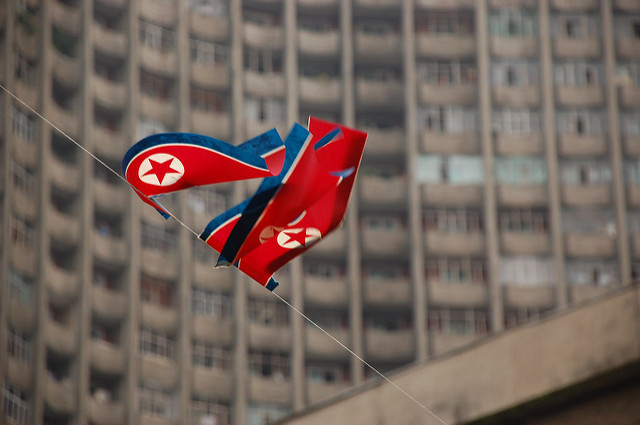
South Korea, Japan and the United States expressed outrage at North Korea’s simultaneous launch of four extended-range SCUD ballistic missiles in early March 2017. The missiles—the most primitive in the DPRK arsenal—splashed down about 1,000 kilometers from the launch site in the Sea of Japan, inside Japan’s EEZ. That spectacular simultaneous launch, which coincided with the start of the annual US–ROK military exercise ‘Foal Eagle’, followed a spate of other launches in the recent past of different missile systems, including the Soviet-era Musudan intermediate-range ballistic missile which has a range of 3–4,000 kilometers but is still under development (that is, not operationally deployed).
An energetic missile-development program, two additional nuclear tests in 2016, and the sharper bellicosity of leadership statements from Pyongyang—spiced, of course, by the bizarre murder of Kim Jong-Nam—are the primary ingredients in this most recent spike in tensions on the peninsula. All that led South Korea to invite the US to deploy THAAD, a more capable ballistic missile defence battery, to the south of Seoul. Beijing saw that move as a threat to China’s security and uncharacteristically threw itself into the dispute, promptly curtailing tourism to South Korea and imposing harshly penalties on the Chinese operations of the South Korean conglomerate, Lotte, signaling that heavier economic blows could follow.
The DPRK wants unconditional negotiations—especially acceptance of the fact that it’s a nuclear weapons state—on the normalisation of its relations with the US and neighbouring states. The US insists that it won’t accept the DPRK as a nuclear weapons state and that any negotiations must be concerned first and foremost with halting and reversing the DPRK’s nuclear program. Chin had backed this US position on North Korea but has reverted to being an interested but somewhat detached observer prepared to offer its good offices to facilitate a peaceful resolution.
All the players, however, have entrenched and deeply-scarred positions. For Pyongyang, any hint that it has been the agent of instability is anathema. It strikes at the heart of the national myth that it barely survived naked US aggression in 1950–53 and has had to focus the nation intensely on deterring the US on every day since that time. The outcome has been a state that’s uniquely repressive, that has impoverished its citizens savagely in favour of supporting disproportionately large armed forces and enormously costly ventures like its nuclear weapon program, and which is incapable of sustaining a normal relationship with a single other state.
For the US, the Korean peninsula has been a relentless challenge of deterrence of the North, reassurance of the South, and regular management of crises. At a time when it was uncontestably the most powerful state in the world, the US was very nearly forced off the Korean peninsula by the surprise North Korean offensive in June 1950. The North Korean attack was enabled by the Soviet Union and endorsed by the People’s Republic of China. It consolidated absolutely Washington’s reluctant acceptance of an enduring state of enmity between East and West in what came to be called the Cold War. US and allied forces prevailed over the North Koreans by October 1950 but then Chinese forces intervened to preclude an absolute victory, a move that created an enduring enmity between China and the US but also exposed a Chinese strategic imperative that endures to this day.
Washington and Seoul, therefore, have a great deal at stake on the Korean peninsula. Washington is perhaps even less likely than Pyongyang to concede that it’s the provocateur. To do so would jettison some 70 years of vigilance and massive cost to engage a state that’s been allowed by the former Soviet Union and China to fabricate a national story that still sustains the most repressive regime of modern times and which now stands on the cusp of being able to threaten Japan and the US (not to mention Australia) with nuclear weapons.
China’s Foreign Minister, Wang Yi, last month made the statesmanlike proposal that, in order to defuse the crisis and set the stage for negotiations, the US and ROK should cancel the Foal Eagle exercises and the DPRK should suspend its nuclear and missile activities. In a less statesmanlike aside, the Foreign Minister demanded that South Korea ‘cease and desist’ deployment of the THAAD battery. It should come as no surprise that Wang Yi’s credibility was zero.
China’s dilemma is that while North Korea has pursued a nuclear weapon capability over the past 30 years or so that, Beijing has taken a strategic holiday, outsourcing the problem (primarily) to the US, discreetly subsidising the regime in Pyongyang and enforcing UN sanctions and export controls on sensitive materials and technology in a casual fashion. Beijing clearly has a vision for the long-term future of the Korean peninsula but until it can see a clear path to implement that vision it prefers to sustain the status quo, even if it means revealing that it attaches no great importance to the proliferation of nuclear weapons, provide they aren’t directed at China. Beijing’s fury at the deployment of THAAD is a classic illustration of how consequential the absence of internal checks and balances can be. There’s been no commentary whatsoever in China (political, academic or media) pointing out that North Korea’s growing proficiency in ballistic missile and nuclear warhead development made something like this inevitable.
This characterisation of the dilemma suggests that there’s no silver bullet or other quick answer out there. The situation demands some thorough transparency so that all the players come to the negotiating table to consider the character of their future relationship without their fabricated armour, or as an Australian Kim might put it, in their smalls.

